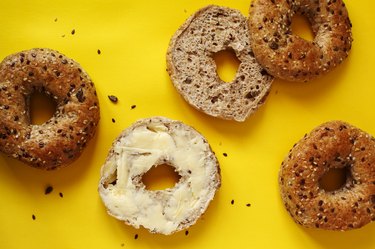
Bread is probably not the first thing you reach for if you're at all concerned about your weight. But bread, as a blanket term, has been vilified largely unjustly. Certain types of bread are well worth strategically including in your daily diet, while others, yes, are best eaten sparingly.
The bottom line is that you can definitely enjoy bread as part of a healthy diet plan. The secret is choosing the right types — and eating them in the right serving sizes.
Video of the Day
Video of the Day
All Breads Are Not Created Equal
Refined bread products, like white bread, flour tortillas, croissants, traditional biscuits and bagels, will quickly add calories to your diet without beneficial fiber or nutrients.
On the other hand, "Whole grain breads contain fiber, B vitamins and certain minerals, such as iron and magnesium," says registered dietitian Daniela Novotny, a biomedical sciences instructor at Missouri State University. "Many of these nutrients have strong associations with optimal health."
This can be especially true of whole-grain breads that are freshly baked at home or in a small-batch bakery, as opposed to shelf-stable, bread-aisle varieties. The latter are typically processed with additives to keep them from going stale or spoiling, and they tend to have considerably less fiber, Novotny says.
If you do need to buy packaged, grocery store bread, though, you can make the best choice by checking the ingredient list on the bag. "Look for 'whole wheat' or 'whole grain' as the first ingredient," Novotny urges, adding that color is not an indicator of whole-grain status. "Additives can be incorporated to make the bread look darker."
Another thing to check for is fiber, she says: Ideally, the bread you choose should have at least 4 grams of fiber per serving.
What's a Serving of Bread?
A single serving is considered 1 ounce, and that's equivalent to one slice, according to the United States Department of Agriculture. Of course, some slices are thicker than others. To be sure about how many servings you are actually eating, read the serving size information on the package carefully. Or, if you're eating a homemade or bakery version, weigh the first slice on a food scale before slicing the whole loaf.
Here's a tip: When you make toast for breakfast, instead of two buttered slices at two servings of bread, fill up on one slice by topping it off with healthy add-ons. "Make one slice of toast a well-rounded meal by adding protein and healthy fats," Novotny advises. Think nut butters or avocado for healthy fats and eggs or low-fat cottage cheese for protein.

What About Other Bread Products?
Breads that aren't actually loaves can be a bit trickier to size up. For example, one whole English muffin, which most of us may easily eat in a sitting, is actually two servings — each half counts as one. If you prefer biscuits, one portion is a small, 2-inch-diameter biscuit.
Bagel lover? Keep in mind that these tend to be bigger than one serving. Most of the ones sold in bagel stores, supermarket bakery departments and coffee shops are equivalent to four servings, Novotny says. The smaller, mass-distributed bagels in the freezer at grocery stores, as well as "mini bagels" in bagel shops, are closer to one serving, though even those can equal two.
Even thin tortillas can be deceiving. If you typically order wraps, you might be getting more servings than you realize. Believe it or not, one 12-inch tortilla, the size usually used to make burritos and sandwiches in restaurants and delis, is equivalent to four 1-ounce servings from the grain group.
How Many Servings of Bread Can You Have in a Day?
The amount of bread you can have in your daily diet correlates with how many calories you take in, according to the American Heart Association (AHA). Your target daily caloric intake depends on several factors, including your age and activity level.
Discussing your ideal nutrition plan and caloric intake with your doctor is a smart first step. As a general benchmark, the AHA recommends aiming for six servings of grains if you're on a 1,600-calorie daily diet, and eight if you take in 2,000 calories a day. Just remember, though, that's for all grains (including, for example, oatmeal, rice and pasta), not just bread.
In a nutshell, bread is like most other foods: healthy if selected carefully and enjoyed in moderation. "Despite the reputation it has gotten, bread is not bad at all," concludes Novotny. "That said, it's important to get in fruits, veggies, lean proteins and dairy foods throughout the day. Variety can keep the diet fresh, so the same foods aren't being consumed every day."